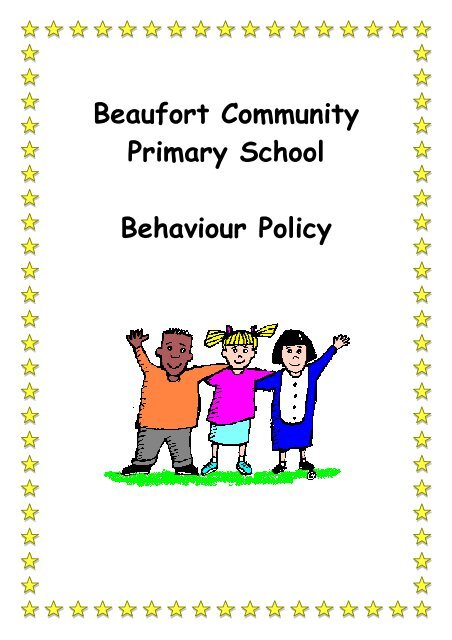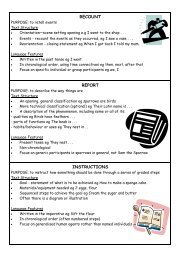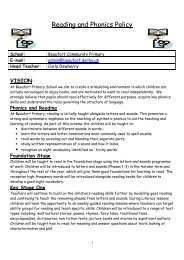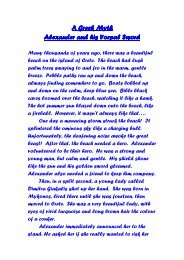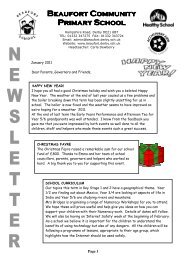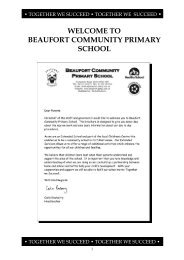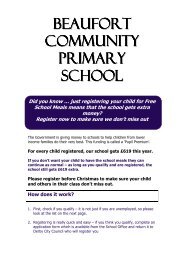Beaufort Community Primary School Behaviour Policy
Beaufort Community Primary School Behaviour Policy
Beaufort Community Primary School Behaviour Policy
Create successful ePaper yourself
Turn your PDF publications into a flip-book with our unique Google optimized e-Paper software.
<strong>Beaufort</strong> <strong>Community</strong><strong>Primary</strong> <strong>School</strong><strong>Behaviour</strong> <strong>Policy</strong>1
<strong>Beaufort</strong> <strong>Community</strong> <strong>Primary</strong> <strong>School</strong> <strong>Behaviour</strong> <strong>Policy</strong>:At <strong>Beaufort</strong> <strong>Primary</strong> school we believe that every member of the schoolcommunity has a responsibility for behaviour and the right to feel valued andrespected. We aim to create a welcoming, caring environment whererelationships are based on respect and develop a positive self-esteem in eachchild. Staff are committed to maintaining high expectations of good behaviouras an essential contribution to the educational experience of the children and totheir well being whilst in school. All staff and students have an entitlement toachieve their maximum potential in a safe and secure environment whereeffective teaching and learning can take place. It is our belief that goodbehaviour needs to be consistently and positively encouraged, valued andcelebrated.Principles:To enable children to be taught effectively, have the opportunity to learn and besafe and happy throughout the day, we believe that all members of the schoolcommunity including children, staff, parents and governors, should:• Have high expectations for their own and others’ behaviour• Respect and support each other, demonstrating a responsibility for others• Show respect for the school environment and equipment• Consider the safety of everyone• Help themselves and other learn• Make a positive contribution and recognise the contribution of others• Be listened to and listen to others• Realise the equal value of all and value differences• Avoid raised voices and aggressive body language• Treat all in a clear, fair, consistent and calm way• Expect and help the classroom to be a quiet, ordered place• Expect the relationship between children and adults to be one of trust• Recognise achievements• Expect good behaviour to be rewarded and sanctions imposed for poorbehaviour.2
Roles and ResponsibilitiesThe Headteacher / Deputy Headteacher will be informed of any seriousbehavioural issues and will work with all members of the school community toensure high standards of behaviour at all times.The role of all staff in school:Good behaviour is encouraged by a well cared for environment and a well orderedpositive learning experience.Staff should therefore:• Make explicit, in a constructive and positive way, what behaviour isexpected of pupils and what is unacceptable• Challenge inappropriate / unacceptable behaviour• Provide pupils with a good role model• Establish consistent classroom procedures• Encourage pupils to set their own goals and maintain a sense ofresponsibility• Create a positive climate and a caring and effective working environment• Encourage relationships based on kindness, respect and understanding ofthe needs of others• Ensure fair treatment of all regardless of age, gender, race, ability anddisability• Show appreciation of the efforts and contribution of all• Promote the idea that every member of the school has responsibilitiestowards the whole communityIt is expected that pupils should:• Follow the school’s rules and expectationsIt is expected that Parents / Carers will:• Ensure that children attend school regularly and arrive on time• Encourages their child / children to be well organised• Contact the school if their child is absent or late• Ensure that their child behaves appropriately whilst at school• Support the school if sanctions are applied to their child for inappropriateor unacceptable behaviour3
It is expected that the governors will:• Support the school in its efforts to address issues related to behaviourmanagementOur school code of conduct:At <strong>Beaufort</strong> we:Treat everyone with respect and politenessStay calm and don’t retaliateMove around sensiblyFollow instructions the first timeAlways do our best and let others do the same.Our Classroom Rules:Classroom rules are negotiated at the beginning of the year with each class.They are referred to throughout the year and children are expected to followthem so that every child has a positive learning experience in the classroom.Our playground Rules:• Always ask an adult if you need to go inside• Always speak to an adult if there is a problem• Stay in your playing area.• Move to your line quietly and sensibly when the bell is rung. Stand quietlyin your line ready to walk sensibly into school.• Play kindly with others.4
Rewards:Our emphasis is on rewards to reinforce good behaviour. We believe thatrewards have a motivational role, helping children to see that good behaviour isvalued. Rewards used at <strong>Beaufort</strong> include the following:• Verbal praise• Ticks on the ‘Smiley face’ board. The child with the most ticks each daywill become special person the following day and have extraresponsibilities.• Achievement stickers, certificates of merit and postcards home• Lottery tickets – a weekly draw will decide the child who will have extraresponsibilities that week• Each teaching assistant will award each week one brick for excellentbehaviour during the week. These rewards will be acknowledged during aweekly assembly.• Teaching assistants will also have the responsibility of selecting a childwho has been particularly helpful, polite, responsible and tidy. In KS1 thiswill happen once a week.• Class stars will be awarded when the class works well as a team – e.g.leaving assembly sensibly. When each class has collected 10 stars this willlead to golden time or a chosen treat.Consequences of poor behaviour:Staff will use discretion and professional judgement in line with the schoolethos. The use of sanctions should be characterised by certain features:• It must be clear why the sanction is being applied• It must be made clear what changes in behaviour are required to avoidfuture punishment• It should be made clear that it is the behaviour rather than the personthat is punished.Below is a list of consequences in the order in which they are given. It isexpected that if a child’s name is written under the ‘sad face’ in the classroom,it will be enough in most cases to deter the pupil from misbehaving further, butin some cases other sanctions need to be used. Occasionally, behaviours areexhibited that make it necessary for a child to go straight to another classroom5
without waiting for crosses to be put on the ‘sad face’. Examples of thesebehaviours are listed below. This may happen in order to protect the safety ofothers or to ensure that others are able to work.Consequences of poor behaviour:1. Verbal / non-verbal warning:Examples include: not doing work, day dreaming, sulking, not listening, workavoidance tactics2. Name on the ‘sad face’ board.Crosses put next to name x3. Each class teacher will log incidents of badbehaviour. These logs will be regularly monitored by the Head teacher / DeputyHead teacher3. Move away from others to work on own in classroom.A child will be moved straight to this sanction for any of the followingbehaviours: tantrum, lying, openly defying adults, kicking, spoiling others’ work,tormenting others, deliberately falling off chair and throwing things.4. Send to another classroom with a child or adult with 5 minute timer for timeout to think about their behaviour.5. Child will be sent to head teacher or deputy head.• A letter will be sent to parents/carers outlining the incident that led thechild to being sent to the head or deputy. The letter will also identify onhow many occasions the child has reached this consequences level of thebehaviour policy.• Where behaviour does not improve or where a serious incident occurs thehead / deputy will contact parents/carers by phone or letter asking themto attend a meeting to discuss their child’s behaviour.• <strong>Behaviour</strong> books and Files will be used to monitor individual pupils’behaviour throughout the day and this book will be sent home daily tocommunicate with parents. This is a short term intervention. The booksare colour coded – red, orange and green. Children will move to the greenbook if it is considered their behaviour has improved over a three weekperiod.• <strong>Behaviour</strong> files are used to monitor those pupils who are at high risk ofexclusion. A teaching assistant is allocated to act as a mentor for thechild. The mentors role is to set targets with the child, discuss the logs6
on a daily basis with the child and to liaise with teachers, SLT andparents/carers. These are intended to be used over a longer period suchas a half term.A child will be sent straight to the Head teacher for serious misbehaviour, e.g.stealing, physical or verbal abuse, bullying, and leaving school premises.6. Exclusion:Exclusion may be for either for a fixed term or permanent. It is the Headteacher’s responsibility to decide whether a child should be excluded. (Refer toLA policy and procedures) Involvement of outside agencies may be used tosupport a child displaying poor behaviour.Early Years Unit:Rewards will be similar to Key Stage 1 but on an immediate and individual basis.Children will receive verbal praise for good work or behaviour and will receive asticker. Also during weekly assemblies – good behaviour will be acknowledged.Sanctions will involve a simple set of procedures which apply over every session:1) Verbal warning (x2)2) Remove child from activity / situation to sit on the ‘thinking chair’3) Return child to activity if behaviour is changed (incident closed)4) If unacceptable behaviour persists the child will stay with an adult foradditional support – positive play / distraction from focus of concern.5) Teacher or AHT to contact parents/carersLunchtime Rewards:Each lunchtime supervisor will award ‘a brick’ for excellent behaviour for theweek.Lunchtime Sanctions:Group activities are used to encourage positive and co-operative play – childrenmay be directed to attend groups where there has been persistentmisbehaviour.Where there is an incident of poor behaviour a child may be asked by alunchtime supervisor to take some time out. This time out will be taken on thepath or in KS1 in a designated area on the playground.7
Persistent poor lunchtime behaviour may result in lunch time exclusion.BullyingBullying is a serious form of misbehaviour. Bullying is usually characterised by:a) dominance of one pupil by another or group of othersb) premeditationc) a pattern of behaviour rather than an isolated incident – Several TimesOn Purpose (STOP)d) repeated racial harassmentBullying incidents are logged by the school and monitored by the local authority.Bullying will not be tolerated at <strong>Beaufort</strong> <strong>Primary</strong> <strong>School</strong>. (Refer to <strong>School</strong> Antibullyingpolicy)Reviewed September 20128
Resources to support the behaviour policy:• Sad face / smiley face• List of class names for the board• Bricks – laminated• <strong>Behaviour</strong> log books for each class• Class stars• TA certificates• <strong>School</strong> Rules – set for each class & 2 x sets for corridors.• Timers9


